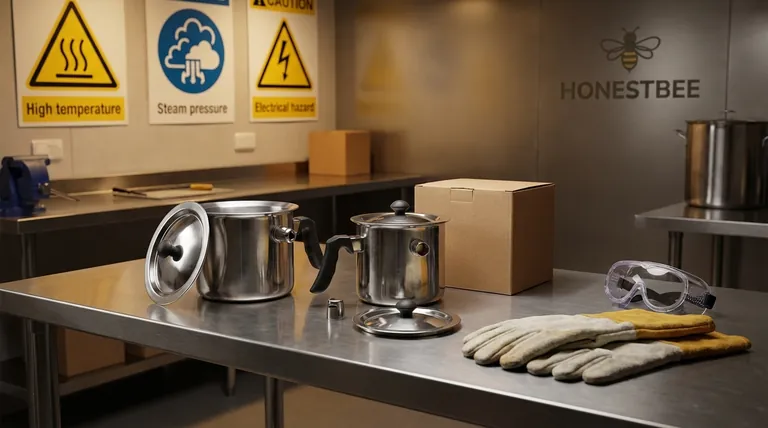The primary safety considerations when using a wax melter revolve around the specific energy source it uses. The main risks include burns from high temperatures, pressure-related dangers with steam models, and the potential for electric shock from electric units.
Your choice of wax melter directly influences the safety protocols you must follow. While all models present a risk of burns, steam and electric melters introduce unique hazards—pressure and electricity—that demand specific operational awareness.

The Universal Risk: High Temperatures and Burns
Regardless of the type, all wax melters operate at temperatures high enough to cause serious burns. This is the most common hazard you will face.
Handling Hot Surfaces
The body of any wax melter, whether solar, steam, or electric, will become extremely hot during operation. Always wear protective gloves and avoid touching the unit with bare skin.
Managing Hot Wax
Melted wax itself is a significant burn risk. Be cautious of splashes when adding or moving wax, and ensure the melter is on a stable, level surface to prevent tipping and spills.
Type-Specific Hazards and How to Mitigate Them
Beyond general heat safety, each type of wax melter has distinct risks tied to its design. Understanding these is crucial for safe operation.
Steam Melters: The Danger of Pressure
Steam generators work by boiling water to create high-pressure steam. If this system is not managed correctly, it can become dangerous.
Excessive heating can cause a rapid buildup of steam pressure. This can lead to a rupture of the boiler tank or cause hoses to burst, releasing scalding steam and hot water.
Electric Melters: The Risk of Shock
Electric melters are convenient but introduce electrical hazards. The primary concern is the integrity of the heating element and wiring.
If an electric heating element breaks or the wiring becomes frayed, it can create a risk of severe electric shock, especially in the potentially wet environment of wax processing. Regularly inspect all electrical components.
Solar Melters: The Safest by Design
Solar wax melters are widely considered the safest option. They use the sun's energy, eliminating the risks of high pressure and electricity.
Their primary drawback is a lack of efficiency and dependence on weather, but from a purely hazard-focused perspective, they present the lowest operational risk.
Understanding the Trade-offs: Safety vs. Efficiency
Choosing a wax melter involves balancing your need for performance against your tolerance for risk and your working environment.
The Power of Steam and Electric Models
Steam and electric melters are popular because they are fast and effective, capable of processing large quantities of wax regardless of the weather. This efficiency comes with the responsibility of managing pressure and electrical systems safely.
The Simplicity of Solar Models
A solar melter's lower efficiency is the direct trade-off for its inherent safety. It has no complex parts, no pressure, and no electrical wiring, making it simple and reliable, albeit slower.
Your Environment Matters
The choice also depends on your workspace. An electric melter requires a dry, safe area with proper electrical grounding. A steam melter is often used outdoors due to the heat and steam it produces.
Making the Right Choice for Your Goal
Select your equipment based on a clear understanding of its operational demands and your own priorities.
- If your primary focus is maximum safety and simplicity: Choose a solar wax melter, as it eliminates pressure and electrical hazards.
- If your primary focus is speed for processing large volumes: A steam or electric model is more effective, but you must commit to rigorous safety checks and proper operating procedures.
- If you are working without reliable access to electricity: A steam melter (with an external heat source like propane) or a solar melter are your most practical options.
By understanding the risks inherent to each design, you can operate your chosen wax melter with confidence and control.
Summary Table:
| Wax Melter Type | Primary Safety Risk | Key Mitigation Strategy |
|---|---|---|
| Steam | Pressure buildup & scalding steam | Avoid excessive heating; inspect hoses and tank regularly. |
| Electric | Electric shock from faulty wiring | Use in a dry area; regularly inspect heating elements and cords. |
| Solar | Burns from hot surfaces (lowest risk) | Wear protective gloves; the design eliminates pressure and electrical hazards. |
Equip your apiary with safe, reliable wax processing equipment from HONESTBEE.
Choosing the right wax melter is critical for protecting your team and your investment. At HONESTBEE, we supply commercial apiaries and distributors with durable, high-performance beekeeping supplies designed with safety and efficiency in mind.
Let us help you select the perfect wax melter for your operational needs and safety standards. Contact our wholesale experts today to discuss your requirements and get a quote!
Visual Guide

Related Products
- Beeswax Melter for Candle Making Honey Bee Wax Melter
- Steam Beeswax Melter Wax Warmer for Wax Processing
- Professional Stainless Steel Wax Melter for Beekeeping and Crafts
- Electric Honey Press Machine for Squeezing Honey Comb Press Equipment
- 10L Stainless Steel Honey Wax Press Extractor for Wax Cappings
People Also Ask
- What is the flashpoint of beeswax? Essential Safety and Quality Tips for Beekeepers
- What are the benefits of using a professional wax melter? Achieve Consistent, Scalable, and Safe Production
- What is the recommended temperature range for melting beeswax? Achieve Perfect Quality & Safety
- How do water jacket melters function? Achieve Gentle, Scorch-Free Melting for Sensitive Materials
- What is the best way to melt beeswax for candles? The Safest Method for Professional Results



















